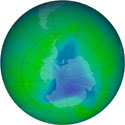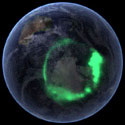|
 |
 |
|
| Upward and onward for Canadian science in 2005 |
|
 |
Astronomy


The BLAST Telescope
and balloon
(Photo: University of Toronto)
|
BLAST: a clearer view of the cosmos
In June 2005, the BLAST telescope travelled from Sweden to the Canadian Arctic while studying the skies. Suspended from a balloon above the Earth's atmosphere, the telescope provides a clearer picture of the cosmos than ground-based ones. All the better for studying stars, galaxies, and other cosmological phenomenon! Data from the mission is being analyzed while a second mission is being planned for 2007 in the Antarctic.
To learn more
|
Canada contributes an instrument to NASA's next space telescope
Canada's contribution to the James Webb Space
Telescope—Hubble's successor—is the Fine Guidance Sensor, currently in its detail design phase. COM DEV is expected to begin manufacturing in November 2006. The sensor will precisely control the main observatory mirror while it takes high quality images. It will also include a tuneable filter for detailed images in the search for the first stars and galaxies formed in the universe. As a partner, Canada is guaranteed telescope time once it is launched in 2013.
To learn more
|

The NGC 4314 galaxy
(Photo: Hubble)
|
Exploration


The planet Mars
(Photo: ESA)
|
Coming soon: Mars weather reports
A Canadian weather station will soon be operating in the Martian arctic. Last October, the Canadian Space Agency awarded $6 million to build the station. Its instruments, including the first lidar to operate from the surface of another planet, will detect Martian clouds, dust, temperature and pressure. The science team will use the new data to assess climate patterns in Mars' northern plains. NASA will launch it in 2007 as part of its Mars Scout lander mission, Phoenix.
To learn more
|
Devon Island: preparing for missions to Mars
In July 2005, members of the Arthur Clarke Mars Greenhouse project headed to Devon Island for another field season to increase reliability so the system functions without failure. Devon Island, a rocky, desert in the Canadian Arctic simulates some of the conditions on Mars. Its remoteness enables scientists to study the effects of isolation and to test technologies that will be used in an environment without electricity, infrastructures, or any traditional means of communication.
To learn more
|

The Arthur Clarke greenhouse
(Photo: CSA)
|
Physical Science


A Russian Foton satellite
(Image: ESA)
|
Oil exploration goes into orbit
Oil exploration got a boost in May 2005 when the Soret Coefficient in Crude Oil (SCCO) experiment was launched on a Russian Foton satellite. The experiment will validate mathematical models to improve oil-prospecting and extraction techniques. One goal of the project is to develop digital simulators that make it easier to estimate oil reserves and how long they will last. The experiment will also study how temperature gradients affect oil wells.
To learn more
|
Life Science

Two months in bed to explore the effects of microgravity
In 2005, 24 women helped scientists learn more about the effects of zero gravity on the human body. As participants in
WISE—the Women International Space Simulation for Exploration at the Institut de médecine et de physiologie spatiales (MEDES) in
France—the women spent two months in bed in a head-down tilt, which simulates microgravity conditions. Two Canadian scientists participated in the project.
To learn more
|

A woman volunteer in the WISE
bedrest study
(Photo: ESA)
|

A 3-D image of a healthy bone
(Image: MEDES)
|
Studying bone loss in space
Scheduled for launch on a Russian satellite in September 2007, the eOSTEO experiment will study bone loss in space so astronauts can better prepare for long missions. Both space science and medical research will benefit from eOSTEO. The research team will study how bone cells behave in the absence of gravity, test new ways to restore their bone-building functions in space, and explore the mechanisms involved in osteoporosis and other diseases.
For more on the first OSTEO experiment
|
Atmospheric Science

A new view of clouds
The new Earth-orbiting satellite CloudSat is set to launch in 2006. Developed by NASA in partnership with the CSA and other organizations, CloudSat will use Canadian-built radar to gather new information on the structure, frequency and volume of clouds, as well as the amount of water and ice they contain, and thereby improve climate models and projections.
To learn more
|

CloudSat
(Image: NASA)
|

Satellite imagery of the ozone layer over the Antarctic in December 2005
(Image: NASA)
|
Canada's SCISAT contributes to atmospheric research
Data collected to date by a Canadian satellite, SCISAT, allowed scientists to better assess the state of the ozone layer. The Atmospheric Chemistry Experiment on board SCISAT has for
its main goal the study of the processes that control how ozone is distributed in the upper atmosphere, particularly in the Arctic. They were able to discover that there was severe ozone depletion over this region during the winter of 2005.
To learn more
|
Sun-Earth Relations

Canadian ground stations for NASA's THEMIS mission
Canadian scientists and engineers are establishing 16 ground-based observatories to gather information on
the northern lights. Data from the ground stations will be compared with information gathered by THEMIS, a constellation of satellites that NASA expects to launch in 2006. The Canadian team has already set up observatories in Inuvik, Whitehorse, Prince George, The Pas, Athabasca, and at the Ekati Diamond Mine. The other sites will be operating by the fall of 2006.
To learn more
|

Satellite imager of the aurora borealis
(Image: NASA)
|

Canada's CASSIOPE will be a
hybrid satellite
(Image: NASA)
|
ePOP advances to the next phase
The ePOP probe, which will be carried aboard Canada's CASSIOPE satellite, is progressing according to plan. The design phase is complete, and all eight instruments are now being manufactured. They will contribute to collect data about solar storms and their harmful impact on radio communications, satellite navigation systems, and other space-based technologies. CASSIOPE is scheduled for launch in 2007.
To learn more
|
|